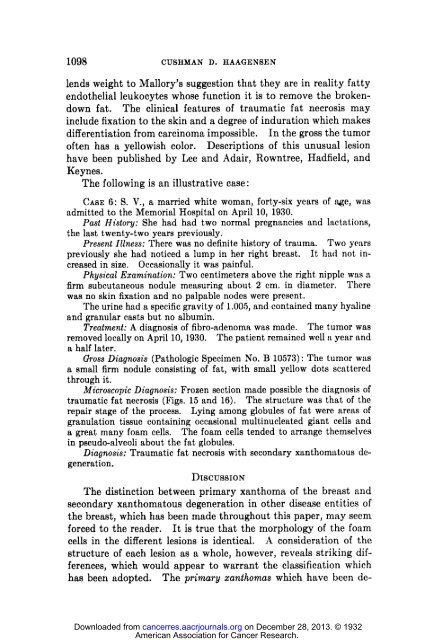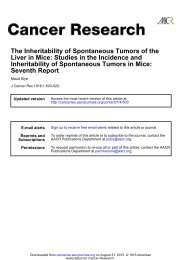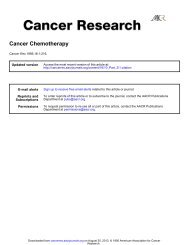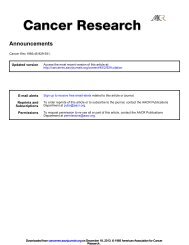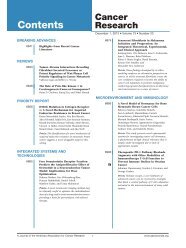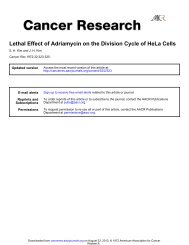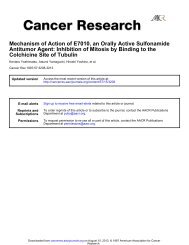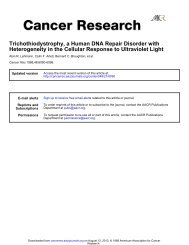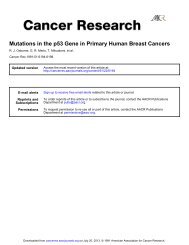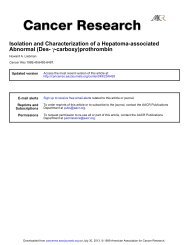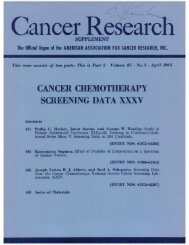XANTHOMA OF THE BREAST In a series of nine hundred (circa ...
XANTHOMA OF THE BREAST In a series of nine hundred (circa ...
XANTHOMA OF THE BREAST In a series of nine hundred (circa ...
You also want an ePaper? Increase the reach of your titles
YUMPU automatically turns print PDFs into web optimized ePapers that Google loves.
Downloaded from cancerres.aacrjournals.org on December 28, 2013. © 1932<br />
American Association for Cancer Research.<br />
1098 CUSHMAN D. HAAGENSEN<br />
lends weight to Mallory's suggestion that they are in reality fatty<br />
endothelial leukocytes whose function it is to remove the brokendown<br />
fat. The clinical features <strong>of</strong> traumatic fat necrosis may<br />
include fixation to the skin and a degree <strong>of</strong> induration which makes<br />
differentiation from carcinoma impossible. <strong>In</strong> the gross the tumor<br />
<strong>of</strong>ten has a yellowish color. Descriptions <strong>of</strong> this unusual lesion<br />
have been published by Lee and Adair, Rowntree, Hadfield, and<br />
Keynes.<br />
The following is an illustrative case:<br />
CASE 6: S. V., a married white woman, forty-six years <strong>of</strong> age, was<br />
admitted to the Memorial Hospital on April 10, 1930.<br />
Past Hisioru: She had had two normal pregnancies and lactations,<br />
the last twenty-two years previously.<br />
Present Illness: There was no definite history <strong>of</strong> trauma. Two years<br />
previously she had noticed a lump in her right breast. It had not increased<br />
in size. Occasionally it was painful.<br />
Physical Examination: Two centimeters above the right nipple was a<br />
firm subcutaneous nodule measuring about 2 em. in diameter. There<br />
was no skin fixation and no palpable nodes were present.<br />
The urine had a specific gravity <strong>of</strong> 1.005, and contained many hyaline<br />
and granular casts but no albumin.<br />
Treatment: A diagnosis <strong>of</strong> fibro-adenoma was made. The tumor was<br />
removed locally on April 10, 1930. The patient remained well a year and<br />
a half later.<br />
Gross Diagnosis (Pathologic Specimen No. B 10573): The tumor was<br />
a small firm nodule consisting <strong>of</strong> fat, with small yellow dots scattered<br />
through it.<br />
Microscopic Diagnosis: Frozen section made possible the diagnosis <strong>of</strong><br />
traumatic fat necrosis (Figs. 15 and 16). The structure was that <strong>of</strong> the<br />
repair stage <strong>of</strong> the process. Lying among globules <strong>of</strong> fat were areas <strong>of</strong><br />
granulation tissue containing occasional multinucleated giant cells and<br />
a great many foam cells. The foam cells tended to arrange themselves<br />
in pseudo-alveoli about the fat globules.<br />
Diagnosis: Traumatic fat necrosis with secondary xanthomatous degeneration.<br />
DISCUSSION<br />
The distinction between primary xanthoma <strong>of</strong> the breast and<br />
secondary xanthomatous degeneration in other disease entities <strong>of</strong><br />
the breast, which has been made throughout this paper, may seem<br />
forced to the reader. It is true that the morphology <strong>of</strong> the foam<br />
cells in the different lesions is identical. A consideration <strong>of</strong> the<br />
structure <strong>of</strong> each lesion as a whole, however, reveals striking differences,<br />
which would appear to warrant the classification which<br />
has been adopted. The primary xanthomas which have been de-


